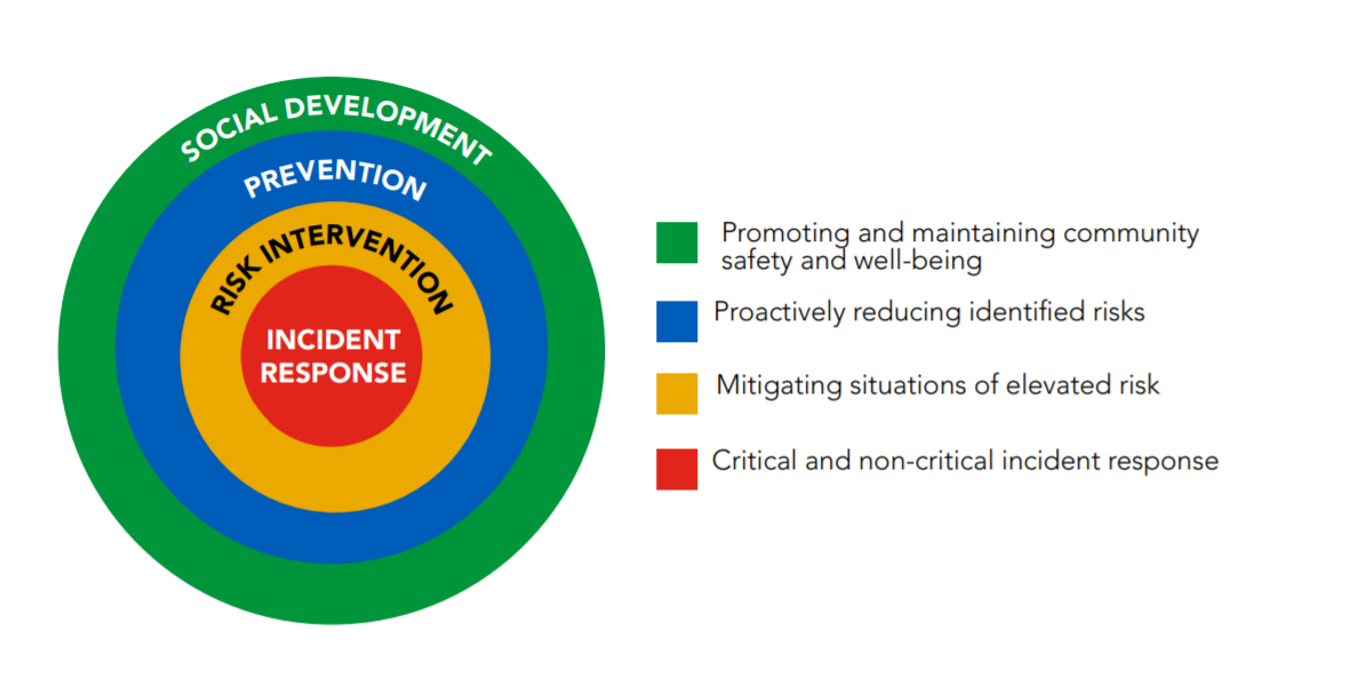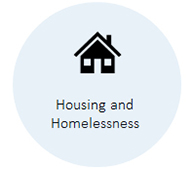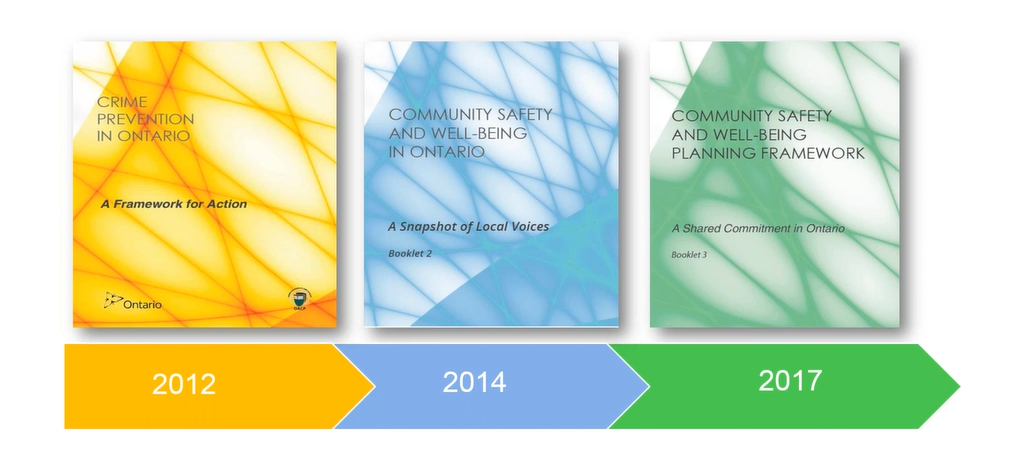Community Safety & Well-Being
If you are in need of a safe space to stay: Emergency shelter is available. If you or someone you know needs a place to sleep tonight, contact A Place Called Home at any time, day or night, to connect with available resources. Call 705-328-0905 and Press 1 to speak with shelter staff, or 1-866-520-2689.
View Kawartha Lakes and County of Haliburton rental listings for this week.
To subscribe to receive weekly rental listing updates, please visit CKL-COH Housing Services website.
If you are experiencing a medical emergency and require immediate assistance, please call 9-1-1.
If you are experiencing a crisis and require access to a mental health helpline, please text or call 1-855-310-COPE (2673); or call or text 9-8-8 for 24-hour, free, confidential support.
Thank you for visiting Haliburton County's Community Safety and Well-Being Plan page!
Looking for recent events and programs?:
Please visit the CSWB events page.
Looking for active surveys?
Our Community Directory survey page is open to members of organizations, agencies and groups working in CSWB-related sectors or with an interest in furthering the work of the Community Safety and Well-Being Plan.
Looking for services in Haliburton County?
To download a copy of the Haliburton Highlands Coordinating Committee Resource Card, please click here. This version was created for distribution during the 2025 Ice Storm state of emergency.
Or read on for further information about Haliburton County's Community Safety and Well-Being Plan:
Haliburton County's Community Safety & Well-Being Plan
The Haliburton County Community Safety & Well-Being [CSWB] Plan was endorsed by county council and its four partner municipality councils in early 2022. The CSWB Plan was created over two years in collaboration between community organizations, partners and service providers, residents, as well as police services, and local government and county leadership.
Community members came together to develop a Plan that provides a roadmap for how partners can work together across different sectors toward a shared vision to make Haliburton County a safer, more inclusive, and connected community for all its residents.
The County of Haliburton was delegated authority for the planning and implementation of the CSWB Plan for the townships of Algonquin Highlands and Minden Hills, and the municipalities of Dysart et al and Highlands East, but the success of the plan itself is not linked to any one person, organization or sector - there is something everyone can do.
About the Community Safety & Well-Being Plan
| What is Community Safety and Well-Being? |
|
The Ministry of the Solicitor General defines community safety and well-being as:
Through this definition, community safety and well-being planning means much more than just ensuring that the basic needs of our communities are met. It also encompasses the broader context of well-being, accounting for social determinants and indicators, alongside the many complex and multifaceted elements of our social and emotional well-being.
|
| Why do we have a CSWB Plan? |
|
New legislative requirements under the Safer Ontario Act, 2018 mandated that each municipality in the province prepare and adopt a CSWB Plan in partnership with a multi-sectoral advisory committee. In Summer 2020, the County of Haliburton began developing our local Plan on behalf of each of the local municipalities. CSWB Planning supports a collaborative approach to addressing local priorities through the implementation of programs/strategies in four planning areas, including social development, prevention, risk intervention and incident response. By engaging in the CSWB planning process, communities will be able to save lives and prevent crime, victimization and suicide. This marks a shift in focus from a reactive, responsive-based approach, to a more proactive, holistic approach to community safety and helps ensure those in need of help receive the right response, at the right time, and by the right service provider. It will also help to improve interactions between police and vulnerable residents by enhancing frontline responses to those in crisis.
Haliburton County's CSWB Plan aims to address the real, everyday needs of our community by improving alignment across our key service providers, integrating data collection and information to better understand and measure progress, supporting vulnerable communities as they access information and services, and ensuring that we are continuously engaging with our community and interested parties to align this plan, with the real everyday needs of our community members. |
|
What are the benefits of a CSWB Plan? |
|
Benefits of planning are wide-ranging and impact individuals, the broader community, and participating partner agencies and organizations. A few key benefits include:
|
Have more questions? Read a Frequently Asked Questions document, or contact us.
Our Plan Priorities and Goals
The ultimate goal of this type of community safety and well-being planning is to achieve sustainable communities where everyone is safe, has a sense of belonging, opportunities to participate, and where individuals and families are able to meet their needs for education, health care, food, housing, income, and social and cultural expression. The success of society is linked to the well-being of each and every individual.
Four key evidence-based priority areas that align with the needs of our community and their service providers are identified in the Haliburton County CSWB Plan: Housing and Homelessness; Poverty and Employment; Mental Health, Substance Use and Addiction, and Healthcare and System Access.
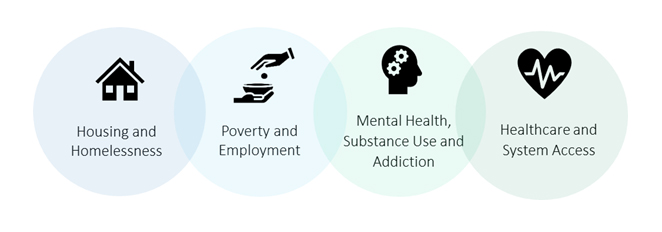
Additionally, each priority area is underpinned by critical enablers - both public and active transportation; streamlined system access/navigation; continuous stakeholder and community engagement; data collection and sharing - as well as risk factors - environment and climate change; geographic distribution; population/demographic-based challenges and public health threats.
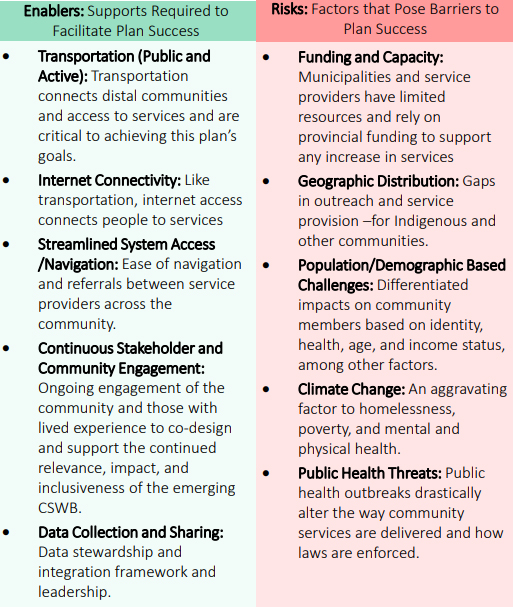
The plan also outlines 12 goals and 25 strategies intended to address some of the community's most critical safety and well-being challenges, which are designed to enhance what already exists in the community and to innovate where key gaps linger.
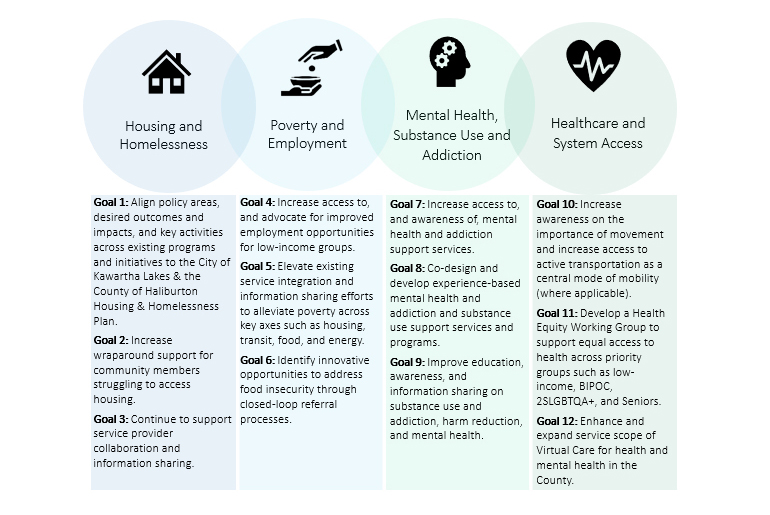
| Housing & Homelessness |
|
Goal 1: Align policy areas, desired outcomes and impacts, and key activities across existing programs and initiatives to the City of Kawartha Lakes & the County of Haliburton Housing & Homelessness Plan Goal 2: Increase wraparound support for community members struggling to access housing Goal 3: Continue to support service provider collaboration and information sharing |
|
Poverty & Employment |
|
Goal 4: Increase access to, and advocate for, improved employment opportunities for low-income groups Goal 5: Elevate existing service integration and information sharing efforts to alleviate poverty across key axes such as housing, transit, food, and energy Goal 6: Identify innovative opportunities to address food insecurity through closed-loop referral processes |
|
Mental Health, Substance Use and Addiction |
|
Goal 7: Increase access to, and awareness of, mental health and addiction support services Goal 8: Co-design and develop experience-based mental health and addiction and substance use support services and programs Goal 9: Improve education, awareness, and information sharing on substance use and addiction, harm reduction, and mental health |
|
Healthcare and System Access |
|
Goal 10: Increase awareness on the importance of movement and increase access to active transportation as a central mode of mobility (where applicable) Goal 11: Develop a Health Equity Working Group to support equal access to health across priority groups such as low-income, BIPOC, 2SLGBTQA+ and Seniors Goal 12: Enhance and expand service scope of Virtual Care for health and mental health in the County |
We encourage all to get involved in helping to implement the CSWB Plan. If you or your organization is interested in supporting one or more of the Plan's goals, please contact our CSWBP Coordinator at cswb@haliburtoncounty.ca.
Read Haliburton County's CSWB Plan
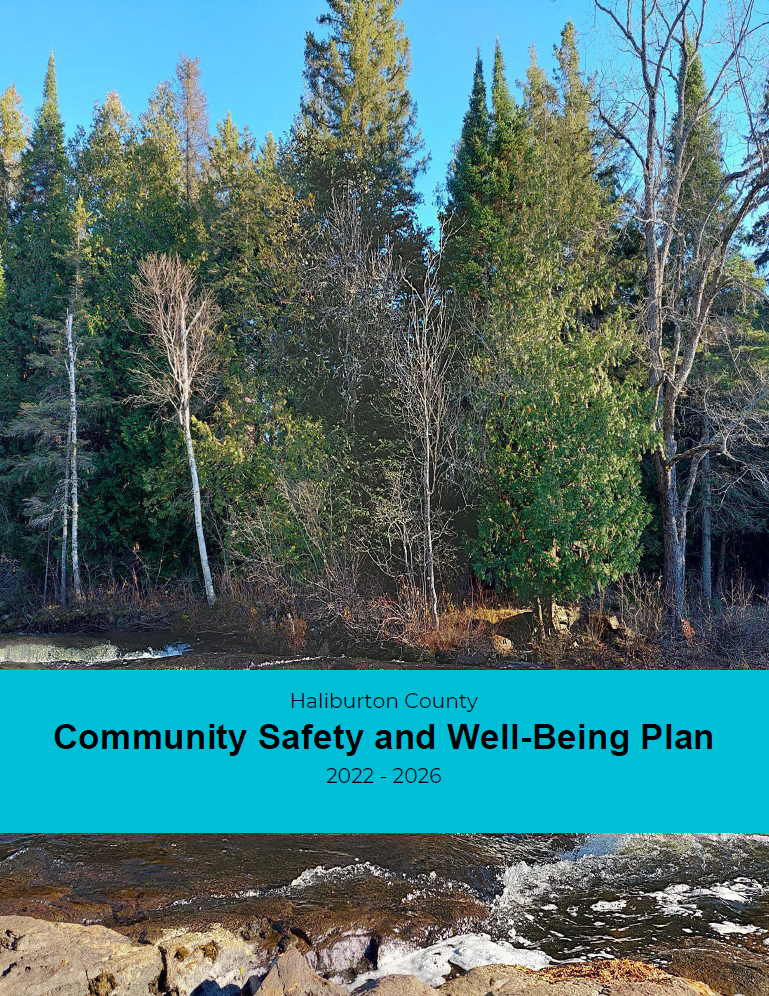
To read Haliburton County's Community Safety and Well-Being Plan (PDF), please click the image to the left or the link below.
Haliburton County's Community Safety and Well-Being Plan (2022-2026).
For more information or for any assistance in accessing this document, please email the CSWBP Coordinator.
[Last update: June 20, 2023]
Implementing the CSWB Plan
As a living document, the Plan acts as a guide for key interested parties to come together, and address community safety and well-being needs in innovative and impactful ways. It is intended to be driven by key partners, interested parties, service providers, and local government alike, and to continuously reflect the changing needs of our community members as progress is made.
Effective implementation and continuation will be based on the following key principles: Good Governance; Data Stewardship and Continued Consultation and Engagement.
Together these principles will help support innovative solutions to community challenges, amplify what already exists in the County and leverage the municipal role in driving our desired CSWB outcomes.
An Advisory Table who will assist the County in developing concrete action plans to address the issues outlined in our plan was originally appointed by county council in June, 2021. The multi-sectoral advisory committee is comprised of service provider representatives and other leaders in the community, and was engaged throughout the Plan development process.
The Advisory Table provided invaluable input and direction on the identification of key priority areas, and what they mean for community members. They are also tasked with driving the continuation of this plan into the future. Representatives include leaders across key issue areas and sectors such as : health and mental health; crisis response and intervention; education; youth engagement; poverty reduction and employment.
| Advisory Table Members |
|
Councillor Bob Carter Councillor Jennifer Dailloux Jennifer Burns-West Marg Cox Nycole Duncan Gary Dyke Staff Sgt. Deb McClure Andrew Hodson (Chair) Jennifer Mills Chris Parish Amanda Rowden Pam Stuckless |
Additional Resources
| CSWB Frequently Asked Questions |
| To read more about Community Safety and Well-Being planning, click here to access a list of Frequently Asked Questions. |
| Provincial Planning Framework |
|
The Ministry of Community Safety and Correctional Services has been working with federal, provincial and municipal partners and local community interested parties to develop a provincial approach to increase community safety and well-being. In 2009, this work began through a partnership between the Ministry and the Ontario Association of Chiefs of Police. This collaboration resulted in resources and legislation designed to support communities throughout Ontario in developing Community Safety and Well-Being Plans. To read these booklets, please click on the links below. Please note the links will open on a new page in a new window. Booklet 1: Crime Prevention in Ontario: A Framework for Action (2012) - HTML Booklet 2: Community Safety and Well-Being in Ontario: A Snapshot of Local Voices (2014) - HTML Booklet 3: Community Safety and Well-Being Planning Framework: A Shared Commitment in Ontario (2017) - HTML
|
|
CSWB Agendas & Reports |
|
Pre-planning discussion
Steering Committee
Council meetings
|
| CSWB Meetings & Presentations |
|
Pre-planning discussion
Steering Committee
Council meetings
|
CSWB Events and Activities
To view past or upcoming events, visit our CSWB Events and Activities page.
Get Involved
- Contact us with:
- Any non-emergency emerging safety and well-being issues you see or experience in Haliburton County (in an emergency, please call 9-1-1)
- Ideas and suggestions on how to improve local safety and well-being
- Information about activities, events or projects related to safety and well-being that we can share with residents
- Requests for further information about Haliburton County's CSWB Plan or services available in Haliburton County
- Connect with the County of Haliburton's Facebook and Twitter pages to stay updated about what CSWB looks like in the county
- Subscribe to this page as it will be updated with further information and resources to connect you with the help you need, or opportunities to get involved in your community
- Are you between the ages of 12 to 24, and living in Haliburton County? Tell us your thoughts through our CSWB Youth Engagement survey
- Are you a member of an organization, agency or group working in CSWB-related sectors? Please complete our Community Directory survey.
Contact Us
Community Safety & Well-Being Plan Coordinator
County of Haliburton
11 Newcastle Street, P.O. Box 399
Minden, Ontario, K0M 2K0
Phone: 705-286-1333 x. 256
Fax: 705-286-4829
Email us: cswb@haliburtoncounty.ca













